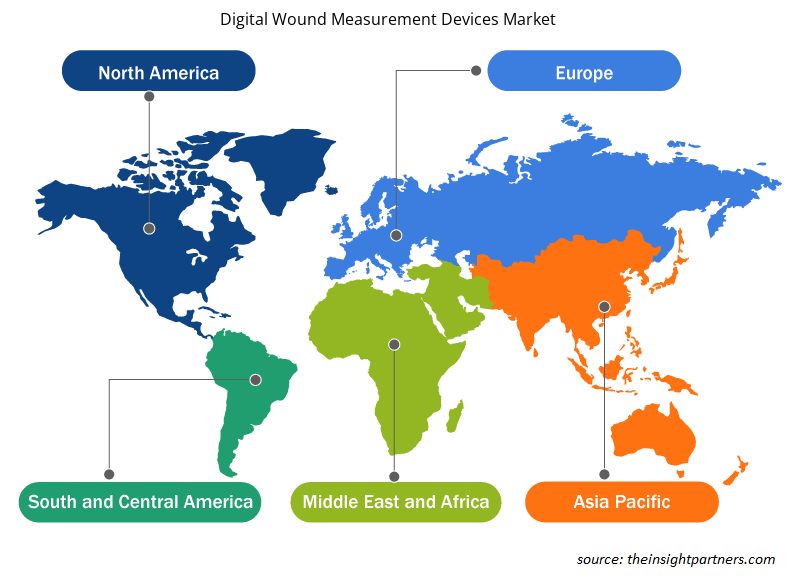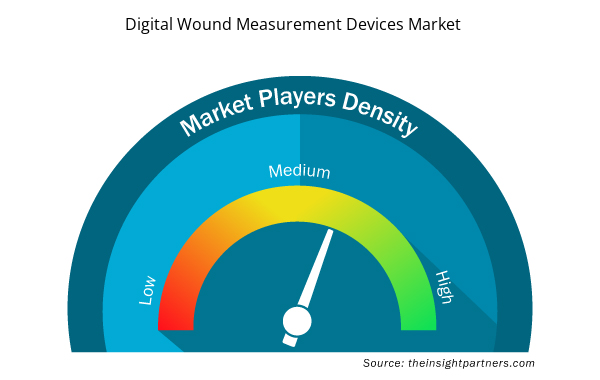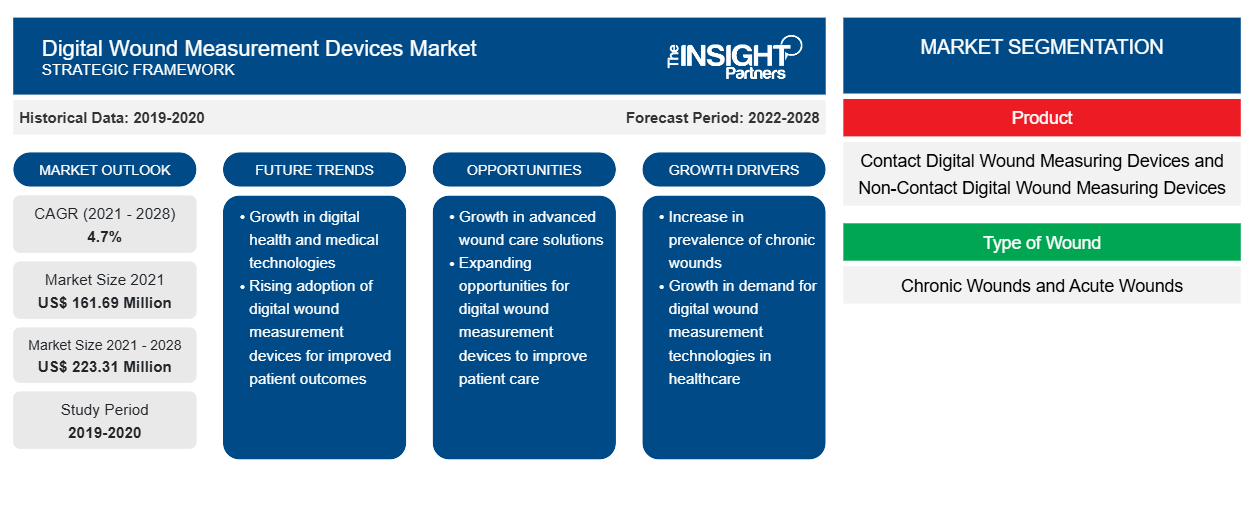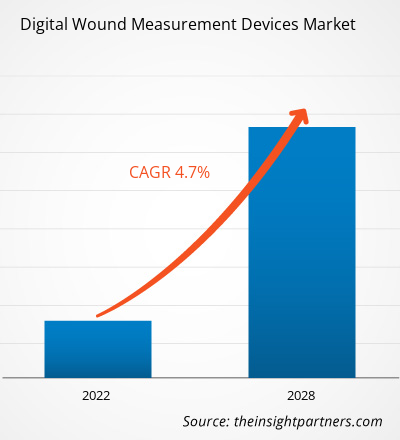[Informe de investigación] Se espera que el mercado de dispositivos de medición digital de heridas crezca de US$ 161,69 millones en 2021 a US$ 223,31 millones en 2028; se estima que crecerá a una CAGR del 4,7% entre 2021 y 2028.
El dispositivo de medición digital de heridas es un dispositivo avanzado que mide las dimensiones de las heridas, como el ancho, la longitud, el área y la profundidad. Estos dispositivos se utilizan para calcular el cambio en las heridas a medida que cicatrizan y, principalmente, convierten el trazado de líneas en una medición del área de la herida. Estos dispositivos ofrecen imágenes, documentación y medición de la herida al ofrecer una evaluación en 3D con la integración del software de registro médico electrónico (EMR). Los resultados inconsistentes en el cuidado de las heridas han influido en los actores de la industria para proporcionar evidencia clínica y mejorar la coordinación de la atención mediante el uso de herramientas digitales para la toma de decisiones y las funciones operativas.
El mercado de dispositivos digitales de medición de heridas está segmentado en función del producto, el tipo de herida, la aplicación, el tipo de dispositivo, el usuario final y la geografía. Por geografía, el mercado de dispositivos digitales de medición de heridas está ampliamente segmentado en América del Norte, Europa, Asia Pacífico, Oriente Medio y África, y América del Sur y Central. El informe ofrece información detallada sobre el mercado, haciendo hincapié en parámetros como las tendencias del mercado, los avances tecnológicos y la dinámica del mercado, junto con el análisis del panorama competitivo de los principales actores del mercado.
Personalice este informe según sus necesidades
Obtendrá personalización en cualquier informe, sin cargo, incluidas partes de este informe o análisis a nivel de país, paquete de datos de Excel, así como también grandes ofertas y descuentos para empresas emergentes y universidades.
- Obtenga las principales tendencias clave del mercado de este informe.Esta muestra GRATUITA incluirá análisis de datos, desde tendencias del mercado hasta estimaciones y pronósticos.
Perspectivas del mercado
El aumento de la incidencia de úlceras contribuye significativamente al crecimiento del mercado
La creciente adopción de estilos de vida poco saludables, el consumo de alcohol y el tabaquismo contribuyen al aumento de la prevalencia de enfermedades no transmisibles. Por ejemplo, en 2018, la Organización Mundial de la Salud (OMS) afirmó que el 13% de los adultos de 18 años o más eran obesos a nivel mundial. Estados Unidos tiene la prevalencia de obesidad más alta (~42,4%), seguido de Arabia Saudita, Turquía, Egipto, Libia, Irán, Irak, Sudáfrica, Canadá, México, Australia y muchos países sudamericanos y europeos. Además, la diabetes afectaba a 34,2 millones de ciudadanos estadounidenses (10,5% de la población) en 2018. La prediabetes afecta a 88 millones de personas y, si no se trata, puede evolucionar a diabetes tipo 2 (DT2) en cinco años. La diabetes afecta a ~4,2% de las personas de entre 18 y 44 años, a ~17,5% de los adultos de entre 45 y 64 años y a ~26,8% de los mayores de 65 años. Por lo tanto, los crecientes riesgos asociados a la diabetes, como las úlceras del pie diabético y las llagas por presión, están aumentando el tamaño del mercado de los dispositivos digitales de medición de heridas. Además, las complicaciones asociadas con la diabetes, como las úlceras del pie diabético (UPD), también están facilitando la necesidad de productos avanzados para el tratamiento de heridas. Por ejemplo, según la Federación Internacional de Diabetes, las personas con diabetes tienen entre 15 y 40 veces más probabilidades de necesitar una amputación de la parte inferior de la pierna. Aproximadamente el 85 % de las amputaciones van seguidas del desarrollo de una úlcera neuropática del pie. Por lo tanto, estos factores están impulsando la demanda de dispositivos digitales de medición de heridas durante el período de pronóstico.
Perspectivas basadas en productos
Según el tipo de producto, el mercado de dispositivos digitales de medición de heridas se divide en dispositivos digitales de medición de heridas sin contacto y dispositivos digitales de medición de heridas con contacto. En 2021, el segmento de dispositivos digitales de medición de heridas sin contacto representó una mayor participación de mercado debido a los avances tecnológicos y la forma eficaz y sin contacto del dispositivo de medir la superficie y el volumen de las heridas.
Tipos de información basada en heridas
Según el tipo de herida, el mercado de dispositivos de medición digital de heridas se divide en heridas crónicas y heridas agudas. Las heridas crónicas se dividen a su vez en úlceras por presión (UPP), úlceras del pie diabético (UPD), úlceras venosas de las piernas (VLU) y úlceras arteriales. Las heridas agudas se dividen a su vez en quemaduras y traumatismos y heridas quirúrgicas. El segmento de heridas crónicas tuvo una mayor participación en el mercado en 2021. Esto se atribuye al aumento de la incidencia de heridas crónicas como úlceras por presión, úlceras del pie diabético, úlceras venosas de las piernas y úlceras arteriales.
Información basada en el tipo de dispositivo
Según el tipo de dispositivo, el mercado de dispositivos de medición de heridas digitales se divide en dispositivos de medición de heridas 3D y dispositivos de medición asistidos por láser. El segmento de dispositivos de medición de heridas asistidos por láser tuvo una mayor participación en el mercado en 2021; se prevé que registre una CAGR más alta en el mercado durante el período de pronóstico.
Perspectivas basadas en aplicaciones
Según la aplicación, el mercado de dispositivos de medición digital de heridas se segmenta en cuidado de heridas, preservación de extremidades y cirugía reconstructiva. El segmento de cuidado de heridas se segmenta además en perfusión sanguínea, terapia de oxígeno hiperbárico, viabilidad tisular y otros. El segmento de heridas crónicas tuvo la mayor participación del mercado de dispositivos de medición digital de heridas en 2021. Sin embargo, se anticipa que el segmento de cuidado de heridas registre la CAGR más alta en el mercado de dispositivos de medición digital de heridas durante el período de pronóstico.
Información basada en el usuario final
Según el usuario final, el mercado de dispositivos de medición digital de heridas se divide en hospitales y clínicas y centros comunitarios. El segmento de hospitales y clínicas tuvo una mayor participación en el mercado de dispositivos de medición digital de heridas en 2021; se prevé que registre una CAGR más alta en el mercado de dispositivos de medición digital de heridas durante el período de pronóstico.
Los lanzamientos de productos, las fusiones y las adquisiciones son estrategias muy adoptadas por los actores del mercado global de dispositivos de medición digital de heridas. A continuación, se enumeran algunos de los desarrollos clave recientes del mercado:
En septiembre de 2021, Kent Imaging anunció la aprobación de Health Canada para SnapshotNIR V3.0 (KD204), que ya está disponible para su envío en ambos idiomas oficiales. Esta actualización proporciona mejoras significativas en las funciones de la tecnología de imágenes que permite avanzar en la evaluación de tejidos en heridas agudas y crónicas.
Dispositivos de medición digital de heridas: segmentación del mercado
Según el producto, el mercado de dispositivos de medición digital de heridas se bifurca en dispositivos de medición digital de heridas de contacto y dispositivos de medición digital de heridas sin contacto. Según el tipo de herida, el mercado se bifurca en heridas crónicas y heridas agudas. El segmento de heridas crónicas se segmenta a su vez en úlceras por presión (UPP), úlceras del pie diabético (UPD), úlceras venosas de las piernas (VLU) y úlceras arteriales. El segmento de heridas agudas se bifurca a su vez en quemaduras y traumatismos y heridas quirúrgicas. Según el tipo de dispositivo, el mercado de dispositivos de medición digital de heridas se bifurca en dispositivos de medición de heridas en 3D y dispositivos de medición asistidos por láser. Según la aplicación, el mercado de dispositivos de medición digital de heridas se segmenta en cuidado de heridas, preservación de extremidades y cirugía reconstructiva. El segmento de cuidado de heridas se segmenta a su vez en perfusión sanguínea, terapia de oxígeno hiperbárico, viabilidad tisular y otros. Según el usuario final, el mercado de dispositivos de medición digital de heridas se bifurca en hospitales y clínicas y centros comunitarios. Según la geografía, el mercado está segmentado principalmente en América del Norte, Europa, Asia Pacífico, Medio Oriente y África, y América del Sur y Central.
Perspectivas regionales del mercado de dispositivos de medición digital de heridas
Los analistas de Insight Partners explicaron en detalle las tendencias y los factores regionales que influyen en el mercado de dispositivos de medición digital de heridas durante el período de pronóstico. Esta sección también analiza los segmentos y la geografía del mercado de dispositivos de medición digital de heridas en América del Norte, Europa, Asia Pacífico, Oriente Medio y África, y América del Sur y Central.

- Obtenga datos regionales específicos para el mercado de dispositivos de medición digital de heridas
Alcance del informe de mercado de dispositivos de medición digital de heridas
| Atributo del informe | Detalles |
|---|---|
| Tamaño del mercado en 2021 | US$ 161,69 millones |
| Tamaño del mercado en 2028 | US$ 223,31 millones |
| CAGR global (2021-2028) | 4,7% |
| Datos históricos | 2019-2020 |
| Período de pronóstico | 2022-2028 |
| Segmentos cubiertos | Por producto
|
| Regiones y países cubiertos | América del norte
|
| Líderes del mercado y perfiles de empresas clave |
|
Densidad de actores del mercado de dispositivos de medición digital de heridas: comprensión de su impacto en la dinámica empresarial
El mercado de dispositivos de medición digital de heridas está creciendo rápidamente, impulsado por la creciente demanda de los usuarios finales debido a factores como la evolución de las preferencias de los consumidores, los avances tecnológicos y una mayor conciencia de los beneficios del producto. A medida que aumenta la demanda, las empresas amplían sus ofertas, innovan para satisfacer las necesidades de los consumidores y aprovechan las tendencias emergentes, lo que impulsa aún más el crecimiento del mercado.
La densidad de actores del mercado se refiere a la distribución de las empresas o firmas que operan dentro de un mercado o industria en particular. Indica cuántos competidores (actores del mercado) están presentes en un espacio de mercado determinado en relación con su tamaño o valor total de mercado.
Las principales empresas que operan en el mercado de dispositivos de medición digital de heridas son:
- eKare Inc.
- Imagen de Kent Inc.
- Matriz de heridas Inc.
- Soluciones perceptivas
- Visión de heridas
Descargo de responsabilidad : Las empresas enumeradas anteriormente no están clasificadas en ningún orden particular.

- Obtenga una descripción general de los principales actores clave del mercado de dispositivos de medición digital de heridas
Perfiles de empresas
- eKare Inc.
- Imagen de Kent Inc.
- Matriz de heridas Inc.
- Soluciones perceptivas
- Visión de heridas
- Aranz Médica Ltda.
- Análisis de tejidos
- Tecnologías de combustible 3D Ltd.
- Hitachi Aloka Medical America Inc.
- MolecuLight Inc.
- Análisis histórico (2 años), año base, pronóstico (7 años) con CAGR
- Análisis PEST y FODA
- Tamaño del mercado Valor/volumen: global, regional, nacional
- Industria y panorama competitivo
- Conjunto de datos de Excel



Report Coverage
Revenue forecast, Company Analysis, Industry landscape, Growth factors, and Trends

Segment Covered
This text is related
to segments covered.

Regional Scope
North America, Europe, Asia Pacific, Middle East & Africa, South & Central America

Country Scope
This text is related
to country scope.
Preguntas frecuentes
The Digital Wound Measurement Devices market majorly consists of the players such as eKare, Inc.; Kent Imaging Inc.; WoundMatrix, Inc.; Perceptive Solution; WoundVision; Aranz Medical Limited; Tissue Analytics; Fuel 3D Technologies Limited; Hitachi Aloka Medical America, Inc.; and MolecuLight Inc., among others.
The global Digital Wound Measurement Devices market is segmented by region into North America, Europe, Asia Pacific, Middle East & Africa, and South & Central America. The largest market for digital wound measurement devices is held by the North American region. The United States held the largest market for digital wound measurement devices, and the market is expected to grow due to technological advancements and the presence of key market players of the digital wound measurement devices in the country. The Asia-Pacific region is expected to be the fastest-growing region with an expected CAGR of 5.2% during the forecast period.
The hospitals and clinics segment are expected to be the leading end user in the digital wound measurement devices market with an expected revenue share of 79.07% in 2021.
The factors that are driving the growth of the market are the increasing incidences of wounds & ulcer and growing number of surgical procedures worldwide. Moreover, the elevated healthcare expenditure is expected to provide growth opportunities to the market. The rise in research activities and product innovations expected to be a future trend that will drive the market’s growth in the coming years.
The non-contact digital wound measuring device segment is expected to be the leading product in the digital wound measurement devices market with an expected revenue share of 75.84% in 2021.
Digital wound measurement devices are aids that assist the physicians in monitoring the wounds by measuring, imaging, tracking and documenting the wounds in terms of size and oxygen level and hence help in selecting the ideal treatment for speeding up the process of healing. These devices are able to provide a two- or three-dimensional assessment of the wounds for calculating the change in area of wound over the time for tracing the healing process.
Trends and growth analysis reports related to Life Sciences : READ MORE..
The List of Companies - Digital Wound Measurement Devices Market
- eKare Inc.
- Kent Imaging Inc.
- WoundMatrix Inc.
- Perceptive Solutions
- WoundVision
- Aranz Medical Ltd.
- Tissue Analytics
- Fuel 3D Technologies Ltd.
- Hitachi Aloka Medical America Inc.
- MolecuLight Inc.
The Insight Partners performs research in 4 major stages: Data Collection & Secondary Research, Primary Research, Data Analysis and Data Triangulation & Final Review.
- Data Collection and Secondary Research:
As a market research and consulting firm operating from a decade, we have published and advised several client across the globe. First step for any study will start with an assessment of currently available data and insights from existing reports. Further, historical and current market information is collected from Investor Presentations, Annual Reports, SEC Filings, etc., and other information related to company’s performance and market positioning are gathered from Paid Databases (Factiva, Hoovers, and Reuters) and various other publications available in public domain.
Several associations trade associates, technical forums, institutes, societies and organization are accessed to gain technical as well as market related insights through their publications such as research papers, blogs and press releases related to the studies are referred to get cues about the market. Further, white papers, journals, magazines, and other news articles published in last 3 years are scrutinized and analyzed to understand the current market trends.
- Primary Research:
The primarily interview analysis comprise of data obtained from industry participants interview and answers to survey questions gathered by in-house primary team.
For primary research, interviews are conducted with industry experts/CEOs/Marketing Managers/VPs/Subject Matter Experts from both demand and supply side to get a 360-degree view of the market. The primary team conducts several interviews based on the complexity of the markets to understand the various market trends and dynamics which makes research more credible and precise.
A typical research interview fulfils the following functions:
- Provides first-hand information on the market size, market trends, growth trends, competitive landscape, and outlook
- Validates and strengthens in-house secondary research findings
- Develops the analysis team’s expertise and market understanding
Primary research involves email interactions and telephone interviews for each market, category, segment, and sub-segment across geographies. The participants who typically take part in such a process include, but are not limited to:
- Industry participants: VPs, business development managers, market intelligence managers and national sales managers
- Outside experts: Valuation experts, research analysts and key opinion leaders specializing in the electronics and semiconductor industry.
Below is the breakup of our primary respondents by company, designation, and region:

Once we receive the confirmation from primary research sources or primary respondents, we finalize the base year market estimation and forecast the data as per the macroeconomic and microeconomic factors assessed during data collection.
- Data Analysis:
Once data is validated through both secondary as well as primary respondents, we finalize the market estimations by hypothesis formulation and factor analysis at regional and country level.
- Macro-Economic Factor Analysis:
We analyse macroeconomic indicators such the gross domestic product (GDP), increase in the demand for goods and services across industries, technological advancement, regional economic growth, governmental policies, the influence of COVID-19, PEST analysis, and other aspects. This analysis aids in setting benchmarks for various nations/regions and approximating market splits. Additionally, the general trend of the aforementioned components aid in determining the market's development possibilities.
- Country Level Data:
Various factors that are especially aligned to the country are taken into account to determine the market size for a certain area and country, including the presence of vendors, such as headquarters and offices, the country's GDP, demand patterns, and industry growth. To comprehend the market dynamics for the nation, a number of growth variables, inhibitors, application areas, and current market trends are researched. The aforementioned elements aid in determining the country's overall market's growth potential.
- Company Profile:
The “Table of Contents” is formulated by listing and analyzing more than 25 - 30 companies operating in the market ecosystem across geographies. However, we profile only 10 companies as a standard practice in our syndicate reports. These 10 companies comprise leading, emerging, and regional players. Nonetheless, our analysis is not restricted to the 10 listed companies, we also analyze other companies present in the market to develop a holistic view and understand the prevailing trends. The “Company Profiles” section in the report covers key facts, business description, products & services, financial information, SWOT analysis, and key developments. The financial information presented is extracted from the annual reports and official documents of the publicly listed companies. Upon collecting the information for the sections of respective companies, we verify them via various primary sources and then compile the data in respective company profiles. The company level information helps us in deriving the base number as well as in forecasting the market size.
- Developing Base Number:
Aggregation of sales statistics (2020-2022) and macro-economic factor, and other secondary and primary research insights are utilized to arrive at base number and related market shares for 2022. The data gaps are identified in this step and relevant market data is analyzed, collected from paid primary interviews or databases. On finalizing the base year market size, forecasts are developed on the basis of macro-economic, industry and market growth factors and company level analysis.
- Data Triangulation and Final Review:
The market findings and base year market size calculations are validated from supply as well as demand side. Demand side validations are based on macro-economic factor analysis and benchmarks for respective regions and countries. In case of supply side validations, revenues of major companies are estimated (in case not available) based on industry benchmark, approximate number of employees, product portfolio, and primary interviews revenues are gathered. Further revenue from target product/service segment is assessed to avoid overshooting of market statistics. In case of heavy deviations between supply and demand side values, all thes steps are repeated to achieve synchronization.
We follow an iterative model, wherein we share our research findings with Subject Matter Experts (SME’s) and Key Opinion Leaders (KOLs) until consensus view of the market is not formulated – this model negates any drastic deviation in the opinions of experts. Only validated and universally acceptable research findings are quoted in our reports.
We have important check points that we use to validate our research findings – which we call – data triangulation, where we validate the information, we generate from secondary sources with primary interviews and then we re-validate with our internal data bases and Subject matter experts. This comprehensive model enables us to deliver high quality, reliable data in shortest possible time.


 Obtenga una muestra gratuita de este informe
Obtenga una muestra gratuita de este informe